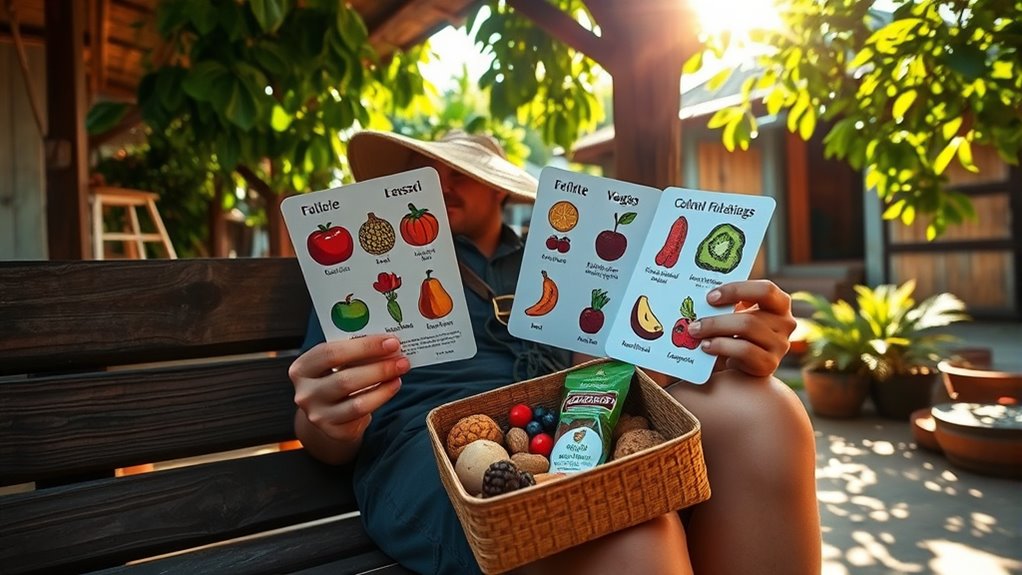When traveling vegan in rural areas, it’s best to prepare small language cards with simple phrases about your dietary needs and local ingredients. Carry portable snacks like nuts, dried fruit, or energy bars to stay energized during long trips or limited food options. These tools help you communicate clearly and avoid misunderstandings while enjoying authentic regional dishes. Keep exploring further tips to make your rural adventure smooth and enjoyable.
Key Takeaways
- Prepare small language cards with essential vegan phrases and local ingredient names for clear communication.
- Pack a variety of portable, non-perishable vegan snacks like nuts, dried fruit, and energy bars.
- Use language cards to ask about vegan options, ingredient substitutions, and confirm meal suitability.
- Research and select accommodations that are accommodating to vegan diets and open to dietary adaptations.
- Carry a list of local ingredients and traditional dishes to facilitate understanding and enhance culinary experiences.

Ever wondered how to maintain a vegan lifestyle when exploring rural areas? Navigating these regions can seem challenging, especially when you’re eager to enjoy authentic local cuisine without compromising your dietary choices. The key is to do a bit of research beforehand. Look for vegan friendly accommodations that understand and cater to plant-based diets. Many rural inns, bed-and-breakfasts, or eco-lodges now offer vegan options or at least are willing to adapt some dishes to fit your needs. Staying in places that are open-minded about dietary preferences not only ensures you’ll find suitable meals but also makes your experience more comfortable and authentic. When you arrive, ask the hosts or staff about local cuisine—many rural areas have traditional dishes that can be veganized or already are. For example, vegetable stews, grains, and legume-based dishes are common in many regions, and with some simple modifications, you can enjoy the flavors without any animal products. Carrying a list of local ingredients or key phrases can help you communicate your needs clearly, preventing misunderstandings and ensuring you’re served something delicious and safe.
To make your experience even smoother, bring along a snack kit filled with vegan-friendly snacks. Think nuts, dried fruit, energy bars, or trail mix—these are portable, non-perishable, and perfect for long drives or remote hikes where options might be limited. Having your snacks on hand prevents hunger-induced stress and keeps you aligned with your vegan lifestyle, even when local options are scarce. Additionally, bringing a small, portable language card with key phrases like “I don’t eat animal products” or “Are there vegan options?” can be a game-changer. These cards can be handed to local vendors or restaurant staff, bridging any language gaps and making communication straightforward. It’s a simple yet effective way to ensure you get the right meal without awkward misunderstandings.
Frequently Asked Questions
How Can I Find Vegan-Friendly Accommodations in Rural Areas?
To find vegan-friendly accommodations in rural areas, start by researching local vegan communities online for recommendations. Look for farmstay accommodations that cater to vegan guests, as they often provide plant-based meals and eco-friendly setups. Use travel apps and websites to filter options, and contact hosts directly to confirm vegan options. Connecting with local vegans beforehand can also give you insider tips and increase your chances of a comfortable stay.
What Are Some Common Rural Cuisine Options Suitable for Vegans?
When exploring rural cuisine options for vegans, look for traditional dishes that highlight local ingredients, such as hearty vegetable stews, grain-based porridges, or fresh salads. You’ll find that many rural communities incorporate seasonal produce, legumes, and herbs into their meals. By focusing on these traditional dishes, you can enjoy authentic flavors while staying true to your vegan lifestyle. Embrace the local ingredients and enjoy the rich, simple tastes of rural cuisine.
How Do I Handle Language Barriers When Ordering Vegan Food?
When facing language barriers, you can use visual translation tools to show pictures of vegan dishes, making it easier for locals to understand your dietary needs. Carrying dietary affirmations on a card helps clarify that you avoid animal products. Simply point to your visuals and confidently present your affirmations, ensuring clear communication. This approach reduces misunderstandings and helps you enjoy vegan meals comfortably, even in rural areas where language differences are more common.
Are There Specific Apps for Locating Vegan Spots in Rural Regions?
Worried you won’t find vegan options in remote areas? Don’t fret—local vegan apps and rural restaurant guides are your best tools. These apps help you locate vegan-friendly spots, even in the most secluded regions. Download them before your trip, and you’ll easily navigate menus and discover hidden gems. They’re perfect for ensuring you stay true to your vegan lifestyle without stress or guesswork in unfamiliar places.
What Tips Help Prevent Cross-Contamination in Remote Vegan Eateries?
To prevent cross-contamination in remote vegan eateries, always ask about kitchen hygiene practices and utensil sharing. Bring your own utensils or request dedicated tools to avoid contact with non-vegan ingredients. Observe how the staff handles food and make sure surfaces are clean before preparing your meal. Clear communication and vigilance help protect your diet, especially in rural spots where kitchen protocols might be less strict.
Conclusion
Traveling vegan in rural areas might seem intimidating, but with your language cards and snack kits, you’re equipped for any adventure. Keep your spirit of exploration alive, just like the brave pioneers of yore, who faced unknown lands with courage. Remember, every journey is a story worth telling, no matter how remote the destination. Embrace the challenge, and let your kindness and curiosity lead the way—your next great adventure awaits beyond the horizon.










